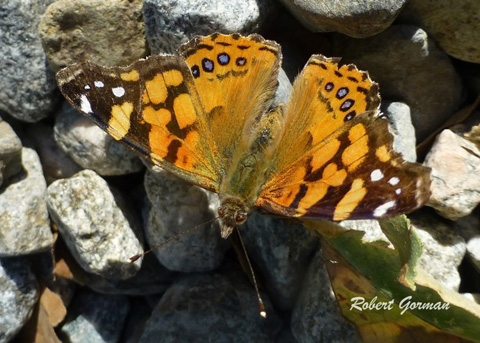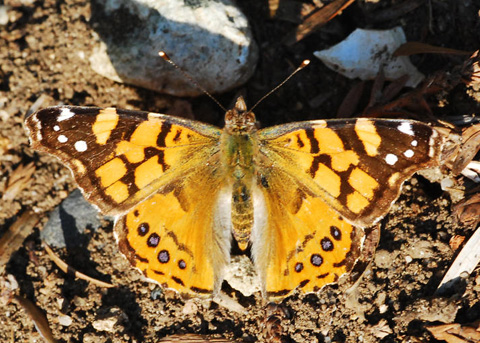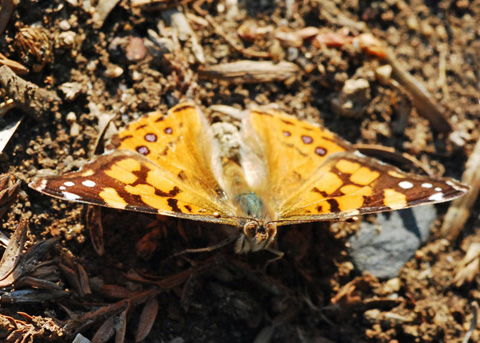 © Peter J. Bryant. |
West Coast Lady
Vanessa annabella Lepidoptera: Nymphalidae Back to Butterflies of Orange County, California |
 Laguna Canyon, Orange County, CA.11-6-13. |
 Laguna Canyon, Orange County, CA.11-6-13. |
 UCI Arboretum, Irvine, Orange County, CA. 2-3-10. © Ron Hemberger |
 UCI Arboretum, Irvine, Orange County, CA. 2-3-10. © Ron Hemberger |
 © Peter J. Bryant. |
|
 Eggs. © Peter J. Bryant. |
 Young larva. © Peter J. Bryant. |
 Older larva. © Peter J. Bryant. |
 Full-grown larva. © Peter J. Bryant. |
 Prepupa. © Peter J. Bryant. |
 Pupa. © Peter J. Bryant. |
Characteristics: Dorsal wing surface deep-orange with various black markings and white apical spots on the dorsal forewing. Ventral hindwing with four eye-like spots near wing margin. Similar Species: The Painted Lady Butterfly (Vanessa cardui). The two may be differentiated by the subapical bar which is orange in annabella, white in cardui. Habitats, Behavior: Often seen basking on bare ground. The species is easily disturbed by shadows or encroaching butterfly nets, at which time it rapidly flies away. However, it will often return to the vicinity (like the Buckeye Butterfly, Precis lavinia coenia). Distribution: Generally distributed in Orange County at lower elevations. Flight Period: The West Coast Lady probably flies throughout the year, being multiple brooded. Ron Vanderhoff records it from May to December in Huntington Beach. Pyle (1974) suspects adult overwintering. In Orange County, most captures have been made in the spring, in April and May. Larval Foodplant: Cheeseweed (Malva parviflora) and Nettle (Urtica holosericea). Cheeseweed is probably most often utilized in Orange County although Ron Vanderhoff records larvae from Urtica holosericea at the Santa Ana River in Costa Mesa. Other Remarks: The West Coast Lady is of occasional occurrence and is not as common as the closely related Vanessa cardui (Painted Lady), except in those years when the latter species is almost absent. In the past, this species was known as Vanessa carye, but carye was found by Field (1971) to actually refer to a distinct species found in South America. From Orsak, L. J. (1977). The Butterflies of Orange County, California. Center for Pathobiology Miscellaneous Publication #3. University of California Press, New York. 349pp. Return to Butterflies and their larval foodplants |
|
